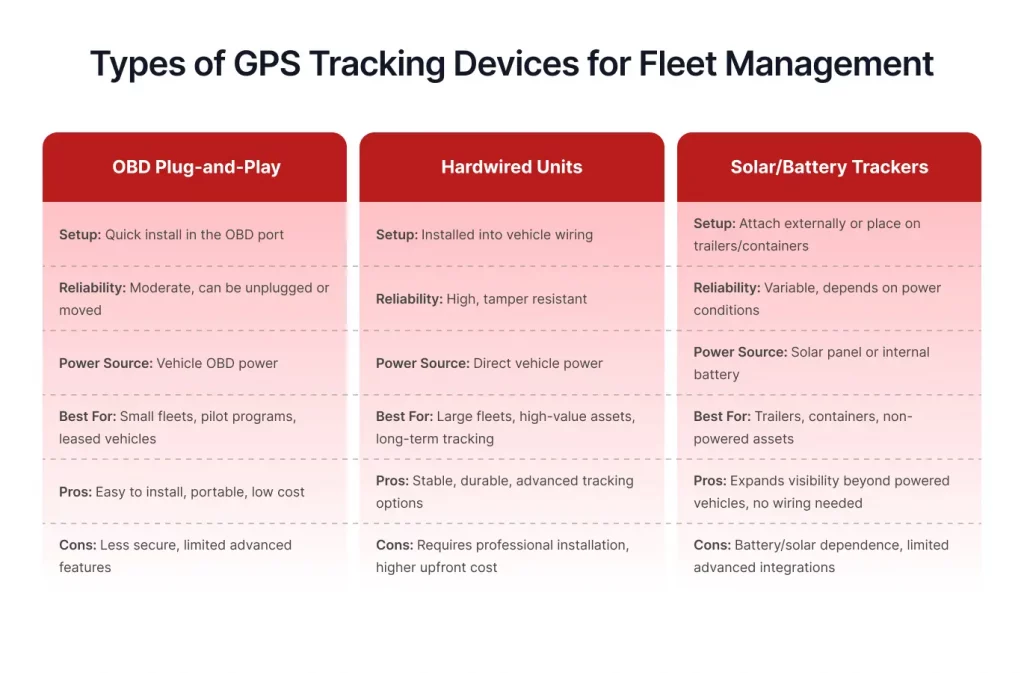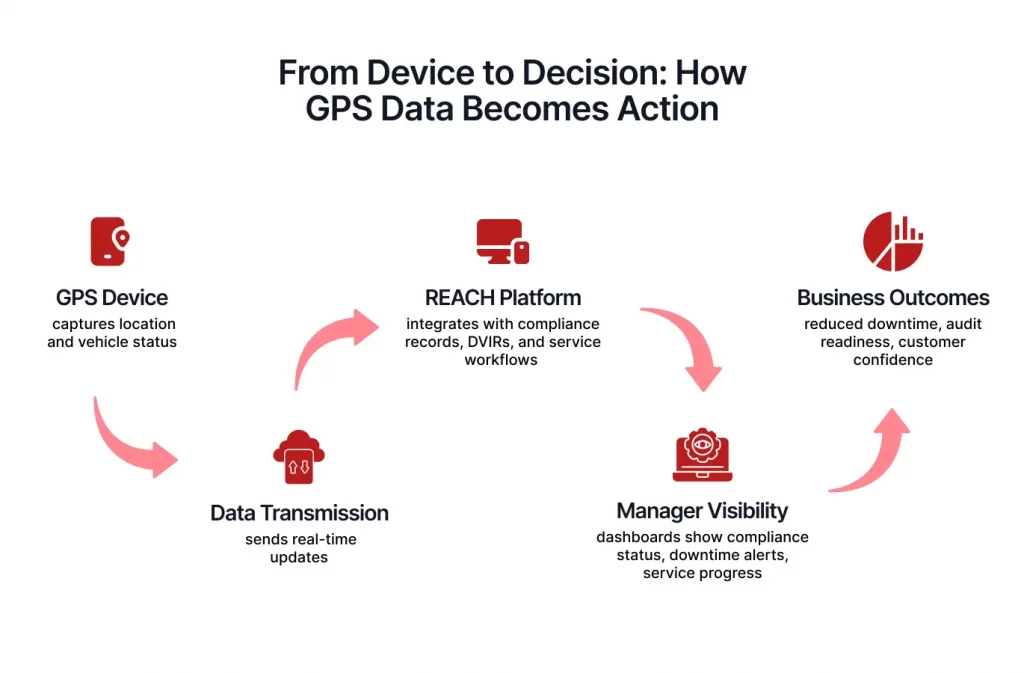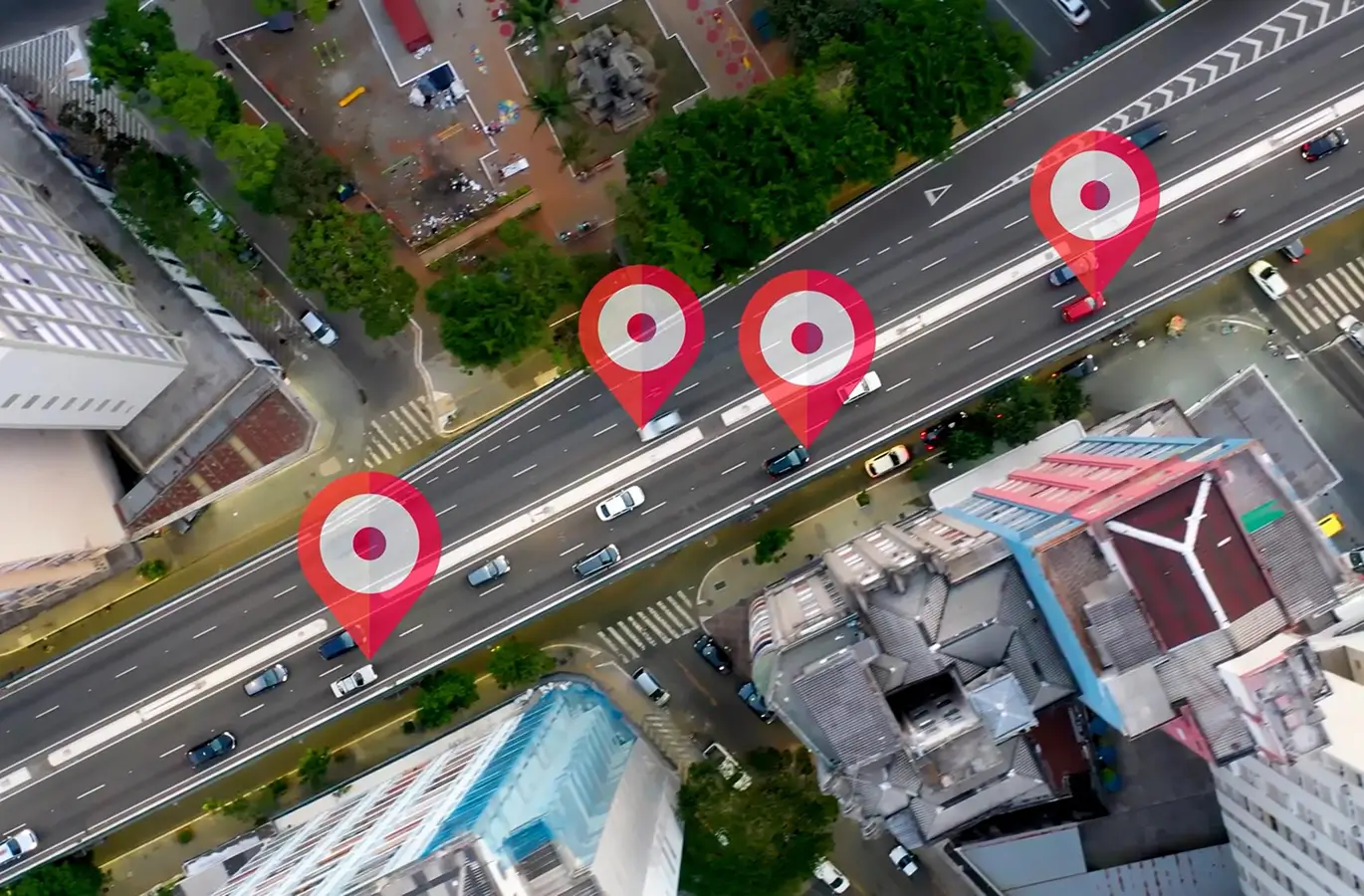In logistics, the strength of any fleet management system begins with the hardware that powers it. GPS tracking devices are the foundation, collecting and transmitting the real-time data that managers depend on. Without reliable devices, even the best software cannot deliver accurate visibility, timely compliance checks, or effective service coordination.
In 2026, fleets face tougher demands than ever before. Customers expect precise ETAs, regulators require audit-ready inspection records, and downtime costs rise with every idle hour. A GPS device that cannot deliver accuracy or durability becomes more than an inconvenience; it becomes a liability.
But hardware alone is not the full answer. A great device only reaches its potential when paired with the right platform. The best GPS tracking device for one fleet may not be the most expensive or feature-heavy model, but the one that integrates seamlessly with compliance workflows, service digitization, and uptime protection.
This guide examines the various types of GPS tracking devices available and the key features that matter most in 2026. Pairing the right device with the right platform, particularly REACH, ensures your fleet achieves measurable results.
What is a GPS Tracking Device in Fleet Management?
At its core, a GPS tracking device is a piece of hardware installed in a vehicle that transmits its location and status in real-time. It communicates with satellites, captures movement, and sends data to a central fleet management platform where managers can monitor operations.
There are several types of GPS tracking devices used in fleet management today:
- Plug-and-Play OBD Devices
- Installed directly into the vehicle’s onboard diagnostic port.
- Easy to deploy, portable between vehicles.
- Ideal for fleets that need a quick setup with minimal installation.
- Hardwired Units
- Permanently connected to the vehicle’s power source.
- Provide reliable, tamper-resistant tracking.
- Best suited for long-term use in large or high-value fleets.
- Solar-Powered or Battery-Operated Trackers
- Suitable for trailers, containers, and equipment that lack a constant power source.
- Extend visibility beyond powered vehicles.
- Ideal for logistics fleets managing a mix of assets.
These devices form the first step of fleet visibility. Yet on their own, they only provide raw data. Their real value is unlocked when paired with a platform that transforms location pings into compliance records, service triggers, and uptime protection.
Types of GPS Tracking Devices

Key Features to Look For in 2026
Choosing a GPS tracking device is not only about picking the latest model. It is about ensuring the device has the necessary features to support compliance, minimize downtime, and provide reliable data that integrates seamlessly with your platform. In 2026, fleets should focus less on flashy extras and more on practical qualities that directly affect performance and ROI.
1. Accuracy and Reliability
A GPS device must provide precise location updates with minimal lag. Delayed or inaccurate data can lead to missed compliance checks, poor route visibility, and frustrated customers. Reliability also means the device continues to work in challenging conditions, such as extreme heat, cold, or poor signal areas.
2. Real-Time Updates
Static location reports are no longer enough. Logistics managers require real-time updates to track vehicle movements, confirm inspections, and identify downtime as soon as it occurs. Devices should deliver data frequently enough to support real-time decisions.
3. Durability and Build Quality
Devices are exposed to vibration, dust, moisture, and varying climates. In 2026, the best devices are designed to withstand rugged conditions. For trailers and containers, weatherproofing is a non-negotiable requirement.
4. Ease of Installation
Fleets cannot afford to lose vehicles to long installation processes. Plug-and-play devices offer simplicity, while hardwired units require professional installation but provide greater stability and reliability. The key is choosing a device that matches fleet resources and deployment speed.
5. Data Integration with Platforms
Raw GPS data is only the beginning. The device should integrate seamlessly with fleet management platforms, allowing location updates to be fed into compliance records, service workflows, and downtime monitoring. Without integration, even the most advanced device delivers limited value.
6. Audit-Ready Compliance Support
Devices that pair with DVIR and inspection workflows add an extra layer of value. They do not just show location; they confirm whether vehicles are compliant, have been inspected, and are ready for audit.
Why the Platform Matters More Than the Device Alone
A high-quality GPS device provides accuracy and durability, but on its own, it cannot transform operations. Real transformation happens when devices feed into a platform designed for compliance and uptime. REACH is hardware agnostic, meaning fleets can use a range of GPS devices. What sets it apart is how it turns raw location signals into workflows that reduce downtime, keep fleets compliant, and provide visibility that customers trust.
From Device to Decision

Devices vs. Platforms, The Real Choice
It is easy to focus on the hardware when evaluating fleet technology. After all, GPS tracking devices are the first layer of visibility. Without them, there is no location data, no compliance link, and no service trigger. Yet fleets that concentrate only on devices risk missing the bigger picture. A device is only as powerful as the platform that interprets its data.
Why Devices Alone Fall Short
A GPS unit can tell you the location of a vehicle. Still, it cannot confirm if inspections are completed, if defects are logged, or if service is underway. Devices generate raw data, not workflows. When fleets rely on devices without a strong platform behind them, managers often end up:
- Juggling multiple dashboards that do not connect
- Manually tracking inspections and repairs
- Losing time chasing updates through phone calls and emails
- Paying for hardware that provides visibility but not control
The result is partial visibility that does not translate into measurable ROI.
Why the Platform Matters
A platform turns GPS data into action. It connects inspection results with service events, shows managers the impact of downtime, and keeps compliance records audit-ready. Instead of raw pings on a screen, managers see actionable insights that help them make informed decisions quickly. The platform enables fleets to transition from reactive management to proactive control.
How REACH Creates the Balance
REACH provides the bridge between GPS devices and real-world results. It does not matter if a fleet uses plug-and-play OBD units, hardwired trackers, or solar-powered devices. What matters is that all of this data flows into REACH’s compliance-first and service-driven platform.
- Compliance becomes automatic with DVIR records tied to GPS data.
- Downtime is reduced because service events are triggered directly by inspection results.
- Customers gain confidence through accurate ETAs and proof of reliability.
This balance enables fleets to invest in devices that align with their assets and budgets, while still reaping the full benefits of a unified platform.
The Real Choice for Fleets
When evaluating options in 2026, the choice is not between one device or another; rather, it is between multiple devices. The real choice is whether to stop at hardware or invest in a system that integrates devices with compliance, service, and visibility. REACH proves that devices deliver their true value only when paired with a platform that turns data into action.
REACH and GPS Tracking Devices
Fleets often ask, “Which GPS tracking device is the best?” The honest answer is that no single device works for every operation. The real advantage lies in how these devices integrate with a management system that ensures compliance, reduces downtime, and enhances customer trust. This is where REACH provides a unique edge.
Hardware Agnostic, Workflow Focused
REACH is designed to work with a variety of GPS tracking devices, from plug-and-play OBD units to hardwired trackers and solar-powered asset monitors. Instead of forcing fleets into a specific device, REACH allows managers to choose hardware that fits their vehicles and budget. The platform then consolidates this data into a single system that focuses on what matters most: compliance and uptime.
Compliance at the Core
Many GPS devices can show a vehicle’s location. Still, REACH ensures that data is tied directly to inspection and compliance workflows. Drivers complete DVIRs digitally, defects trigger service requests automatically, and all records are stored in a format that is always audit-ready. The device becomes more than a tracker. It becomes a compliance safeguard.
Turning Data into Uptime
GPS devices on their own generate pings. REACH converts those pings into actionable workflows. When an issue is reported, it is logged, tracked, and resolved through service coordination built into the platform. Managers can monitor progress in real time and know exactly when vehicles will be back in service. The result is reduced downtime and measurable financial benefit.
Customer Trust Through Visibility
Logistics contracts are won and retained based on reliability. REACH strengthens customer confidence by ensuring that GPS device data is not just accurate but also connected to the workflows that guarantee safe, compliant, and timely delivery.
Why REACH Stands Apart
Other systems emphasize the devices themselves. REACH emphasizes outcomes. It ensures that, regardless of the GPS tracking devices a fleet deploys, the result is the same: safer vehicles, faster service, reduced downtime, and stronger customer relationships. By focusing on integration rather than hardware limits, REACH enables fleets to future-proof their operations while keeping technology practical and easy to adopt.
Buyer’s Checklist for GPS Tracking Devices
Before choosing a GPS tracking device, fleets should consider factors beyond brand names and price tags. The right questions ensure the device integrates seamlessly into daily operations and delivers a lasting ROI.
Buyer’s Checklist
- Is the device accurate and reliable in all environments?
- Can it provide real-time updates rather than delayed reports?
- Is it durable enough for harsh fleet conditions?
- Does installation match fleet needs, whether fast plug-and-play or secure hardwired?
- Does it integrate with a platform that supports compliance and service workflows?
- Will the data help reduce downtime and improve customer confidence?
A device that checks all of these boxes becomes more than a tracker. It becomes part of a system that protects uptime and compliance.
Why Devices Need the Right Platform
In 2026, GPS tracking devices will continue to be the foundation of fleet visibility. They provide location, status, and accountability. But devices alone cannot transform logistics. Their true value lies in being paired with a platform that ensures compliance, digitizes service workflows, and minimizes downtime.
REACH delivers exactly that. It works with a wide range of GPS devices, converting their data into actionable insights that managers can rely on. From DVIR compliance to service coordination and customer visibility, REACH ensures devices are more than hardware. They become tools for profitability and trust.
For fleets planning their next investment, the smartest choice is not just the right GPS device but the right platform behind it. With REACH, fleets gain the confidence that every device installed contributes directly to safer vehicles, faster service, and stronger customer relationships.
Key Takeaways
- GPS tracking devices are the foundation of fleet management, but their value depends on integration.
- In 2026, accuracy, durability, real-time updates, and platform connectivity are must-have features.
- Devices alone provide raw data; platforms turn data into compliance and uptime.
- REACH is hardware agnostic and ensures devices feed directly into workflows that reduce downtime.
- The best investment is not just in a device, but in a system where devices and platforms work together.
Frequently Asked Questions (FAQ)
-
What is a GPS tracking device for fleet management?
A GPS tracking device is hardware installed in vehicles or assets that transmits real-time location and status data. When paired with a fleet management platform, it helps monitor compliance, reduce downtime, and improve logistics visibility.
-
What types of GPS tracking devices are used in fleets?
The most common types are plug-and-play OBD devices, hardwired units, and solar or battery-powered trackers. Each has strengths: OBD devices are quick to install, hardwired units are secure and reliable, and solar or battery trackers extend visibility to trailers and containers.
-
What features should I look for in a GPS tracking device in 2026?
Key features include accuracy, real-time updates, durability, ease of installation, and seamless integration with a fleet management platform. Devices that support compliance and service workflows provide the most value.
-
Why are platforms as important as devices?
Devices only provide raw data. A platform like REACH turns that data into actionable workflows, linking it to DVIR compliance, service digitization, and downtime management. This is what creates measurable ROI.
-
Does REACH require a specific GPS tracking device?
No. REACH is hardware agnostic. It works with a wide range of devices, ensuring that regardless of the chosen type, the data is transformed into compliance records, service events, and operational visibility.
-
How do GPS tracking devices improve customer experience?
By delivering accurate ETAs, minimizing service disruptions, and ensuring vehicles are compliant and safe, GPS tracking devices give customers confidence that shipments will arrive reliably.



